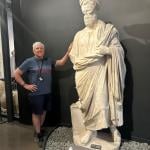 Richard J. Bautch and J. Todd Hibbard (eds)
Richard J. Bautch and J. Todd Hibbard (eds)
The Book of Isaiah: Enduring Questions Answered Anew. Essays Honouring Joseph Blenkinsopp and his Contribution to the Study of Isaiah.
Grand Rapids, MI: Eerdmans, 2014. 234 pages.
Available at Amazon.com
Joseph Blenkinsopp is the John A. O’Brien Professor Emeritus of Biblical Studies at Notre Dame. While he has been based at Notre Dame since 1970, he has lectured widely and has been President of the Catholic Biblical Association (1988-1989), Guest-Professor at Pontifical Biblical Institute, Rome, 1998, and President of the Society for the Study of the Old Testament, U.K. (1999-2000).
Blenkinsopp has published over 17 books and more than 100 book chapters and journal articles on aspects of the Old Testament, including the Pentateuch, the Prophets, and the Persian period. His Anchor Bible Commentary on Isaiah (3 volumes, 2000-2003) has been particularly influential in Isaiah studies, and his contribution to Isaiah studies is honoured in this volume. The editors, former doctoral students of Blenkinsopp’s, have gathered 13 essays from leading Isaiah scholars which interact with Blenkinsopp’s contribution while extending the field of study.
The book opens with personal reminiscences of Blenkinsopp by Philip Davies who presents a warm picture of a careful scholar who is also a good friend. The book is divided into two sections, ‘Exegetical Studies’ and ‘Thematic Essays’, together these give a helpful overview of current Isaiah studies.
The first section contains detailed studies on sections of Isaiah such as ‘“An Initial Problem”, The Setting and Purpose of Isaiah 10:1-4’ in which H.G.M. Williamson explores the redactional layers of Isaiah to consider the current location of chapter 10.1-4. While scholars have noted the similarities of 10.1-4 to the woe-saying in chapter 5, Williamson notes the integrating role of these verses in their current position and argues that the segment is a ‘later redactional conclusion to a previous section of the book’. ‘The Lament in Isaiah 63:7-64:11 and its Literary and Theological Place in Isaiah 40-66’ (Lena-Sofia Tiemeyer), and ‘”Build Up, Pass Through”: Isaiah 57:14-62:12 as the Core Composition of Third Isaiah’ (Andreas Schuele) consider the redaction of Second and Third Isaiah. Interspersed with these studies are wide-ranging reflections, such as ‘On the structure and formation of the book of Deutero-Isaiah’ (Rainer Albertz) and ‘Joseph Blenkinsopp as an interpreter of “Third Isaiah”’ (Hans M. Barstad). Albertz notes Blenkinsopp’s insights into Isaiah 40-55 including the alternation between Zion and Servant passages, and the connections between the Jacob/Israel section (chapters 40-48) and the Zion/Jerusalem section (chapters 49-55). He then proposes a detailed reconstruction of the formation of Isaiah 40-55. Blenkinsopp’s interest in socio-cultural matters is picked up in ‘The legal capacity of women in the biblical tradition of the Persian period’ (Klaus Baltzer and Peter Marinkovic).
The second section considers themes such as kingship, servanthood, eschatology, and consumerism. Willem A.M. Beuken considers the seams within the book in the light of the establishment of Yhwh’s sovereign rule on Mt. Zion, ‘Major Interchanges in the Book of Isaiah Subservient to its Umbrella theme: the Establishment of Yhwh’s Sovereign Rule at Mt. Zion (Chs. 12-13; 27-28; 39-40; 55-56).’ Hyun Chul Paul Kim explores the theme of exalting the humble and crushing the lowly in ‘Little Highs, Little Lows: Tracing Key Themes in Isaiah.’ In ‘Kingship and Servanthood in the Book of Isaiah’, Ulrich Berges considers the relationship between the ‘king’ and the ‘servant’ in Isaiah. Berges considers that the royal Davidic line ends in Isaiah 36-39, and that Yhwh is king. The servant/s of the final sections of Isaiah are the community of the servants in Zion. Marvin Sweeney in ‘Eschatology in the Book of Isaiah’ argues that Isaiah is to be read as a single work that is focussed on Zion. Patricia K. Tull explores ‘back to nature’ themes in ‘Consumerism, Idolatry, and Environmental Limits in Isaiah.’ The book concludes with an article on Second Temple interpretation, ‘Isaiah’s Interpretive Revolution: How Isaiah’s Formation Influenced Early Jewish and Christian Interpretation’ (Jacob Stromberg).
As a reader less familiar with contemporary Isaiah scholarship, I found it helpful to read the second section first, and then go back to read the more specific and detailed articles in the first section. I recommend this book to students seeking insight into recent trends in Isaiah scholarship. The bibliographies are also very useful.
Jill Firth is an Anglican priest and lectures in Hebrew and Old Testament at Ridley College Melbourne.











